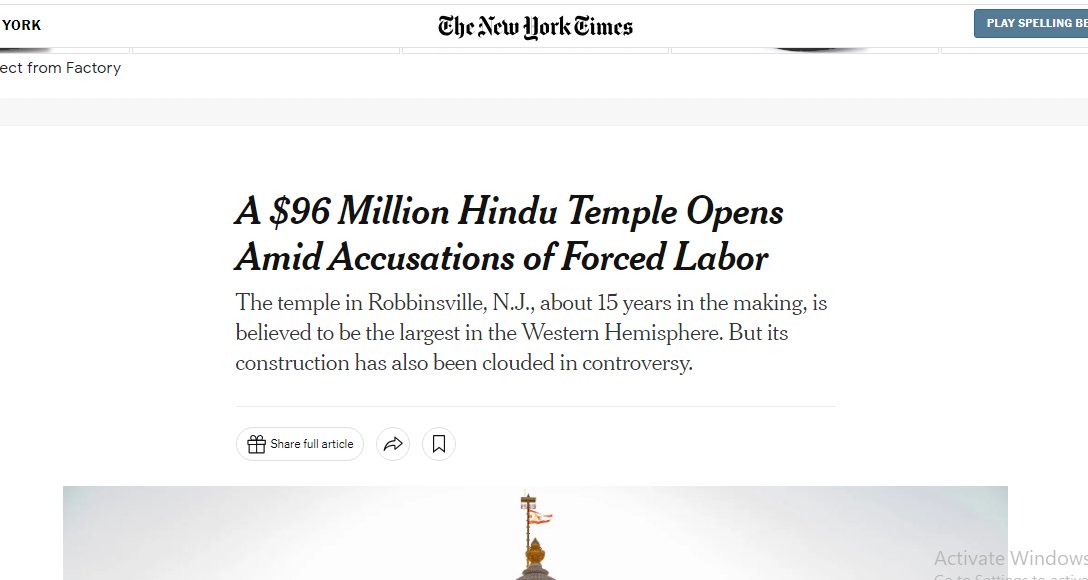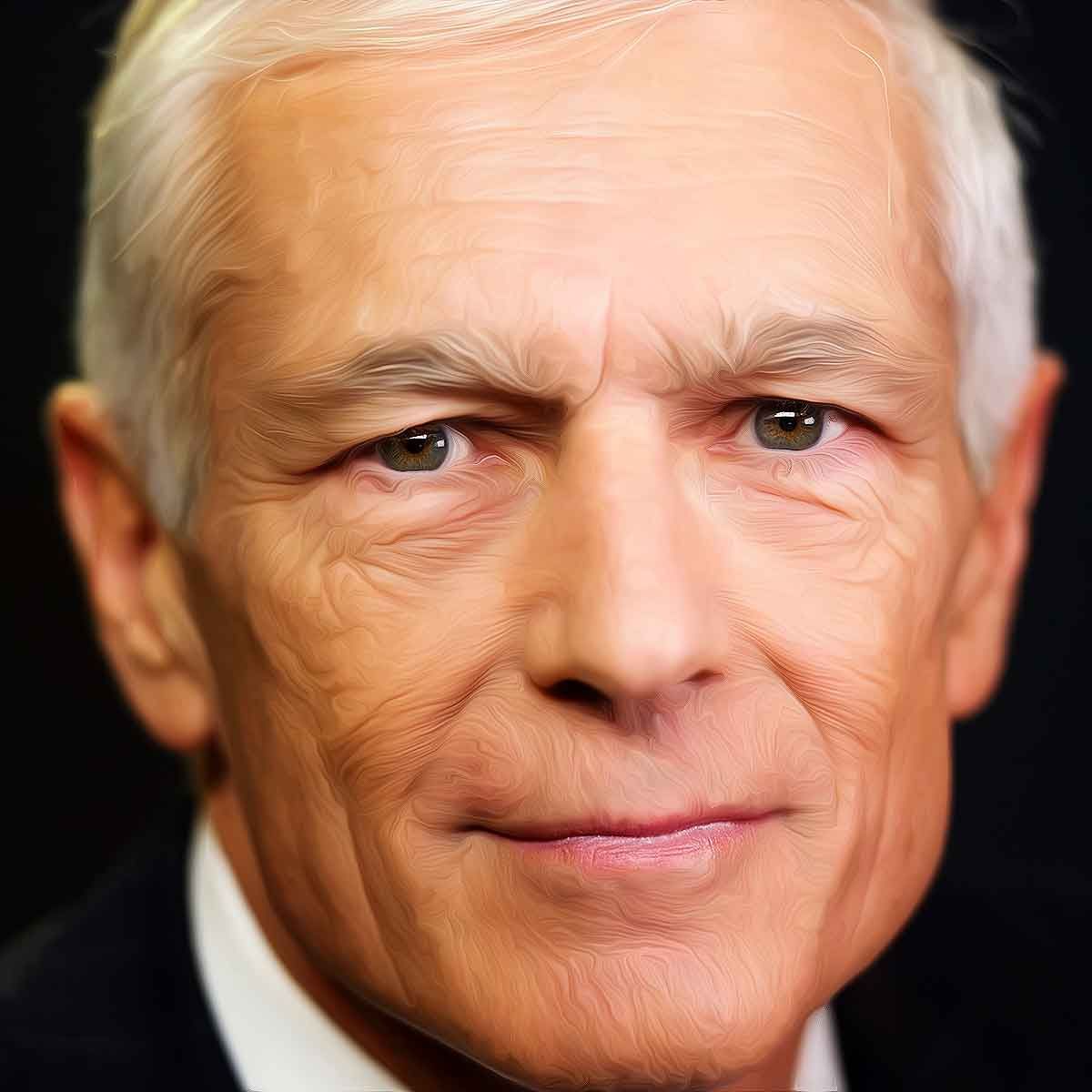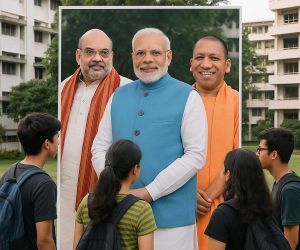MORE COVERAGE
Twitter Coverage
Satyaagrah
Written on
Satyaagrah
Written on
Satyaagrah
Written on
Satyaagrah
Written on
Satyaagrah
Written on
JOIN SATYAAGRAH SOCIAL MEDIA
In a self-revealing blunder, The New York Times attempts to target Akshardham Mahamandir in the US with unsubstantiated 'caste discrimination' claims, conveniently overlooking evidence of artisans being enticed with green cards to fabricate tales

In what appears to be an uninformed attack on the revered Akshardham Mahamandir in the US, The New York Times has come under scrutiny for publishing allegations of 'caste discrimination' without robust verification. This critique comes on the heels of Bochasanwasi Akshar Purushottam Swaminarayan Sanstha (BAPS) successfully defending themselves in a 2-year legal tussle centered around the same baseless accusations.
Located in Robbinsville, New Jersey, the Swaminarayan Akshardham temple stands as a beacon of Hindu faith and culture outside Asia. Recognized as the world's second-largest Hindu temple and undeniably the most visited outside the Asian continent, its significance in the global Hindu community is unparalleled.
 |
| Screengrab of the news report by The NYT |
It raises eyebrows, then, that The New York Times would resort to such a strategy. Given the temple's esteemed position, some critics argue that the publication's continuous focus on it stems from an underlying bias or resentment against its growing prominence. The temple, representing the resilience and unity of the Hindu community worldwide, has faced a series of challenges during its construction. Accusations, baseless lawsuits, and delays seemed to follow it relentlessly.
However, the sequence of events paints a rather telling picture. If one were to critically analyze the trajectory of The New York Times' involvement, it could be summarized as follows: First, there was a palpable intent to halt the temple's construction. When those efforts proved futile, the next step was to cause delays. And when the delay strategy didn't pan out, accusations and lawsuits came into play. Despite the temple's victorious emergence from these legal battles, The New York Times has chosen to rehash old tales by referencing their previous uncorroborated articles.
This chain of events not only showcases the resilience of the Hindu community but also raises significant questions about the integrity and intentions of some media outlets. As the Akshardham Mahamandir continues to welcome visitors from all over, one can't help but wonder: Why the persistent focus on tarnishing its image? And at what point does objective journalism give way to hidden agendas?
|
The New York Times Rehashes Two-Year-Old Allegations Against Akshardham Mahamandir
In a recently published piece on 21st October, The New York Times brought back to light allegations from 2021 surrounding the Akshardham Mahamandir's construction site in Robbinsville, New Jersey. The newspaper reported that "Federal law enforcement agents raided the temple construction site in 2021 after workers accused the builders, a prominent Hindu sect with connections to Prime Minister Narendra Modi of India and his ruling party, of forced labor, inadequate wages, and subpar working conditions."
Further delving into specifics, The New York Times wrote, "Their lawyers said workers who were Dalit, the lowest rung in India’s caste system, were specifically targeted. A federal criminal investigation is ongoing, as is a wage claim lawsuit." Such statements made by the paper suggest an intention to reignite an issue that, for the most part, has been addressed.
|
Notably, it has been two years since the aforementioned raid took place, and during this period, no substantial evidence could substantiate these allegations against the temple authorities. The nature and the timing of these resurfaced claims have led many to question the motivations behind The New York Times' decision to revisit an old narrative.
"Even as visitors are making their way to the Robbinsville temple, the treatment of some of the people who worked on its construction is still at issue. When the temple was raided in 2021, dozens of workers were taken from the construction site," the article stated. This highlights a pressing concern about worker treatment that the temple faced back in 2021.
|
Further elaborating on the legal complications that arose, the article went on to say, "Twenty-one temple workers filed a lawsuit that year, though this month, 12 of them pulled out of the suit. Their lawyer, Aaditya Soni, who is based in Jaipur, said in a text message that the workers believe the facts of the case are false and that they decided to pull out based on religious conviction." This development signals a shift in stance by a significant portion of the workers initially involved in the lawsuit.
Adding another dimension to the narrative, The New York Times underscored a tragic incident from 2017, where a young boy reportedly lost his life at the construction site. Patricia Kakalec, a lawyer spotlighted in the piece, has since pledged her commitment to represent the laborers associated with the temple's construction.
Interestingly, the timing of this article by The New York Times coincided with the temple's grand public opening. Launched by BAPS on 18th October, this monumental project, which spans a decade and a half in the making, now stands majestically as the largest temple in the Western Hemisphere. It thus remains to be seen how the contrasting narratives of the temple's magnificence and the controversies surrounding its construction will play out in the public discourse.
|
|
Amidst the jubilation and spiritual fervor as countless Hindu pilgrims are converging on the newly inaugurated Akshardham Mahamandir to witness its splendor and immerse in its divine ambiance, The New York Times has yet again raised eyebrows. The renowned newspaper, in its recent publications, has sought to temper the celebratory mood with revived and contentious claims of caste discrimination, a narrative that seems all too familiar.
It is worth noting that this isn't an isolated incident of The New York Times targeting the Hindu community or its institutions. In 2021, the newspaper aimed its scrutiny at the Bochasanwasi Akshar Purushottam Swaminarayan Sanstha (BAPS). They alleged, without substantial evidence, that BAPS actively engaged in caste-based discrimination, specifically against Dalit artisans. An article on 11th May 2021 carried the headline, ‘Hindu Sect Is Accused of Using Forced Labor to Build N.J. Temple.’
Continuing in the same vein, the paper furthered its narrative on 10th November 2021 with another piece titled, “Hindu Sect Accused of Using Forced Labor at More Temples Across U.S.” Moreover, to bolster this perspective, the newspaper went the extra mile by publishing a guest essay, which aimed to propagate the notion of caste discrimination by Hindus in the United States.
Given this backdrop, it is crucial for readers and pilgrims alike to discern between the grandeur and sanctity of the temple and the allegations that have resurfaced. As with all narratives, it's essential to approach them with a discerning mind, weighing the evidence at hand and understanding the broader context.
|
Revelations and Revelations: The Alleged Conspiracy Against BAPS
A new chapter has emerged in the ongoing saga surrounding the Bochasanwasi Akshar Purushottam Swaminarayan (BAPS) temple in New Jersey. This time, it pertains to the very artisans who were at the heart of the allegations against the temple. On 13th July, in a significant turnaround, more than a dozen of these artisans, previously involved in a lawsuit against BAPS, chose to withdraw their names from the case.
The genesis of this lawsuit dates back to May 2021. The filed complaint in the United States of America accused BAPS of employing forced labor for the temple's construction and even went to the extent of alleging human trafficking. The magnitude and severity of these allegations undoubtedly cast a shadow over the otherwise revered and grand temple project.
However, the narrative took an unexpected twist. Rajasthan High Court Advocate Aaditya SB Soni, representing the artisans, issued a press release under the banner of Bharatiya Majdoor Sangh and Patthar Gadhai Sangh. The statement revealed startling details, suggesting that the artisans had been coerced into becoming a part of a conspiracy aimed at obstructing the temple's construction.
|
In their declaration, these volunteer stone carving artisans disclosed that they were unwillingly made participants in this alleged scheme. The artisans openly admitted that they had been entrapped in this conspiracy but have since chosen to break free from it. This led them to take the decisive step of retracting from the civil complaint previously lodged against the Hindu temple in an American court.
Advocate Soni, representing a significant group of over 25 artisans, highlighted that his clients had served as devoted volunteers for the religious stonework at the BAPS Hindu Mandir in Robbinsville, New Jersey. Their selfless dedication to the temple was a testament to their faith and devotion.
This latest revelation underscores the intricate layers and complexities surrounding the temple's construction narrative, urging readers to be both cautious and discerning when navigating these multifaceted allegations.
A significant number of the artisans, close to a dozen, have now come forward, revealing that they were unduly coerced into becoming plaintiffs in the civil complaint lodged in the New Jersey court. This complaint became the very basis on which the Federal Bureau of Investigation (FBI) undertook a dramatic intervention on 11th May 2021. The FBI's action involved entering the temple premises and subsequently taking away a substantial number of artisan volunteers on the premise of alleged human trafficking. Out of the 134 artisan volunteers present, a staggering 110 were taken into custody by the authorities.
However, a turning point ensued when some of these artisans reached out to Advocate Aaditya SB Soni, shedding light on a crucial development. They alleged that an attorney from the US, identified as Swati Sawant, had misguided them into lodging the complaint in the first place. In light of this newfound clarity, they expressed their wish to disengage from the ongoing lawsuit.
The issued press release further elaborated on these claims, stating, “These artisans have made strong claims that Swati Sawant and her companions impressed upon them and misled them, using false temptations, to make a complaint against the temple management.”
An essential aspect to note in this evolving narrative is the history and relationship these artisans share with the BAPS temple. Many have willingly provided their skilled services for BAPS temples, both in India and the US, spanning several years. During their tenure with the temple, they affirm that they never once encountered any undue pressure, caste-based discrimination, or any form of ill-treatment.
In a press release published, a profound statement was made, shedding light on the environment and treatment these artisans experienced during their tenure with the temple. It said, “These artisans have clarified that they were treated with love and respect at the BAPS Swaminarayan temple, where they served and were well cared for.”
Advocate Aaditya SB Soni, representing these artisans, added substance to these claims. As per his statement, the temple left no stone unturned in ensuring the artisans' well-being. Not only were their flight tickets to the USA covered, but they were also provided with comprehensive facilities, ranging from lodging, boarding, clothing, to even healthcare and medication. Their family members in India were taken care of, and the artisans themselves had the liberty to frequently visit their families in India and return to the US as per their convenience.
|
However, the press release further highlights a concerning allegation. Advocate Soni brings to light the immense pressure the artisans were under, particularly from US attorney Swati Sawant. They were allegedly warned against revealing the truth, being told that their fellow artisans might report them to the US police, which could lead to their incarceration. Furthermore, the artisans claim that they were lured into making false allegations with promises of American citizenship for both them and their families, coupled with significant monetary benefits.
Such revelations present a complex scenario that requires a deep dive into the motivations, truths, and potential misconceptions surrounding the matter.
The tale of the artisans associated with the Akshardham Mahamandir in Robbinsville, New Jersey, becomes murkier as more details come to the surface. Enticed with promises of American citizenship and financial rewards, some artisans were allegedly coaxed into making untruthful allegations against the temple they had been serving.
According to a recent press release, the artisans initially cooperated with the FBI due to the allure of these offers. However, upon realizing the implications of making false accusations, they began having second thoughts. “They realised they were caught in a conspiracy and wished to return home,” the statement read. Their families back in India, equally concerned, implored them to return.
US attorney Swati Sawant reportedly played a significant role in this situation. Not only did she emphasize the promise of American citizenship and monetary rewards to the artisans, but she also allegedly contacted their families in India, trying to persuade them to ensure the artisans remained in the US. However, as the truth dawned upon these artisans, they sought the assistance of lawyer Aaditya SB Soni.
What followed highlights the artisans' resolve to set things right. Those who had been party to a lawsuit against the temple, feeling they had been led astray, opted to withdraw their complaints. They approached Soni to assist them in formally retracting their allegations with the American legal system.
Prabhuram Meena, the stalwart General Secretary of Bharatiya Paththar Ghadhai Avam Nirman Majdoor Sangh, brought to the spotlight the artisans' retreat from their initial complaints. Advocate Soni, stood tall in the artisans' corner, throwing a spotlight on the theatrical antics allegedly showcased by the US attorney, Swati Sawant.
|
Ms. Sawant, in a role fit for a dramatic courtroom movie, allegedly played the dual cards of intimidation and seduction. According to Soni, she dangled the dark cloud of police reports over the artisans, while simultaneously luring them with the glittering dream of American citizenship and a pot of gold. It's quite the strategy, one might say: why use a stick or a carrot when you can employ both?
But the pièce de résistance in this unfolding drama is none other than The New York Times. This bastion of "unbiased" reporting, which earlier painted in vivid strokes tales of 'caste discrimination' and 'human trafficking', seems to have suddenly misplaced its paintbrush, conveniently overlooking the latest twists and turns in the saga. One might wonder if their paint only flows in shades that suit a particular narrative.
In this grand theatre of media reporting, one is left pondering: when does a news story transition from a pursuit of truth to a crafted tale for eager consumers? One hopes for more discerning eyes in the audience.
The Twisting Web of Accusations and Defense
In May 2021, a thunderstorm of allegations arose from a group of Indian artisans stationed in the US. Their claim? A narrative of human trafficking, forced labor, and a sinister pay rate as meager as a single dollar. This was all supposedly unfolding behind the grandeur of the Swaminarayan temple in Robbinsville, New Jersey. But that was not all. BAPS, they declared, used a similar bait-and-switch strategy in various other iconic locales, including Atlanta, Chicago, Houston, and Los Angeles, promising a grand monthly stipend only to allegedly deliver a paltry USD 450.
However, BAPS swiftly retorted with a narrative of their own. They highlighted the sacredness of "seva" or service in their sect, emphasizing how worship through voluntary service has always been an intrinsic element of devotion. BAPS painted a picture of global volunteers enthusiastically offering their skills, basking in social interactions, and constantly staying connected with their loved ones in India. The idea that these artisans were isolated or oppressed seemed foreign to BAPS's version of events.
|
Furthermore, BAPS didn't just stop at verbal affirmations. They took a dive into logistics, emphasizing the artisans' legal entries into the US with R-1 visas. These visas, BAPS pointed out, had received the golden stamp of approval from the federal government for two decades. Moreover, it wasn't just the artisans who were under scrutiny; the very construction projects they worked on had been subject to routine inspections by various government bodies and had always passed with flying colors.
In this labyrinthine maze of accusations and defenses, truth might feel elusive, but one thing is certain: every story has multiple facets, and understanding the complete narrative requires looking beyond the surface.
|
Conclusion: Unraveling the Threads of Malice and Misinformation
The narrative surrounding the allegations against the BAPS temple unveils a pattern that extends beyond mere accusations. It is an illustrative example of a broader campaign to tarnish the image of a Hindu temple, an integral part of a religious community that holds significant cultural and spiritual value for millions around the world.
The New York Times (NYT), a leading global media house, emerges prominently in this episode, not just as a neutral reporter of events but as a protagonist with its own set of biases. Historically, the publication has demonstrated tendencies that some perceive as being skewed against India and Hinduism. It is essential to ask: Is this an isolated incident, or is it part of a deeper-rooted predisposition?
A constructive critique of the NYT would underline the numerous instances where its coverage seemed to lack balance and nuance when it came to India and Hinduism. From portraying the diverse and ancient Hindu faith through a narrow, often distorted lens to its alleged attempts at amplifying divisive narratives within the Indian context, the publication has courted controversy time and again. In the recent BAPS episode, the absence of updates to counter-narratives or newer developments further clouds its stance, suggesting a preference for sensationalism over objective journalism.
|
However, the plot doesn't stop at media biases. Enter Swati Sawant, whose role in the BAPS narrative further complicates matters. Allegedly acting as the puppet master behind the scenes, her actions, as described, present a portrait of coercion and deceit. The use of fear as a tool, promising grand rewards like American citizenship and monetary benefits, and the continuous pressure on the artisans not only casts a shadow on her professional integrity but also raises questions about the authenticity of the entire case. If the allegations against her stand true, Sawant's role is not merely that of a lawyer representing a case but of an orchestrator of a wider conspiracy.
The implications of such actions are multi-fold. On one level, they have the potential to strain India-US ties by perpetuating negative stereotypes about Indian communities and their practices. On another level, they could potentially create fissures within the Hindu community itself, leading to a loss of trust in its institutions. This orchestrated attempt to malign a Hindu temple, instead of promoting inter-faith understanding and harmony, appears to drive wedges based on unfounded or exaggerated allegations.
In summary, the controversy surrounding the BAPS temple, when viewed against the larger backdrop of media biases and alleged professional misconduct, serves as a cautionary tale. It underlines the importance of discernment and critical thinking in today's information age. While media houses like the NYT wield significant power in shaping global narratives, their potential biases and editorial slants necessitate a more discerning readership. Moreover, professionals like Sawant, if found culpable, must be held accountable for their actions to preserve the sanctity of the justice system.
 Support Us
Support Us
Satyagraha was born from the heart of our land, with an undying aim to unveil the true essence of Bharat. It seeks to illuminate the hidden tales of our valiant freedom fighters and the rich chronicles that haven't yet sung their complete melody in the mainstream.
While platforms like NDTV and 'The Wire' effortlessly garner funds under the banner of safeguarding democracy, we at Satyagraha walk a different path. Our strength and resonance come from you. In this journey to weave a stronger Bharat, every little contribution amplifies our voice. Let's come together, contribute as you can, and champion the true spirit of our nation.
 |  |  |
| ICICI Bank of Satyaagrah | Razorpay Bank of Satyaagrah | PayPal Bank of Satyaagrah - For International Payments |
If all above doesn't work, then try the LINK below:
Please share the article on other platforms
DISCLAIMER: The author is solely responsible for the views expressed in this article. The author carries the responsibility for citing and/or licensing of images utilized within the text. The website also frequently uses non-commercial images for representational purposes only in line with the article. We are not responsible for the authenticity of such images. If some images have a copyright issue, we request the person/entity to contact us at This email address is being protected from spambots. You need JavaScript enabled to view it. and we will take the necessary actions to resolve the issue.
Related Articles
- Call it communism, 'wokeism' or Left leaning political ideology; secularism for sure has its ways to lose a friend
- Radical Mohammedans chopped off Dilbar Negi's limbs and burnt him alive, the Islamic mob torched properties of Hindus till 24th Feb night: Fresh charge sheet against 12 in Delhi riots
- After strong reactions from the public on the decision to change the logo of the prestigious institute IIM-Ahmedabad, now institute backtracks that only minor changes in color rendition and fonts
- Delhi University professor Dr Ratan Lal booked for making vile derogatory statements on Shivling discovered inside disputed Gyanvapi structure, which came to light during the Court-ordered survey
- Tension gripped Baghpat after a Hindu boy Sandeep Dudhiya was brutally attacked by his Muslim friend Muhammad Feroze, who slit his throat with a sharp knife: The boy is battling for his life
- City Police booked Railway Police sub-inspector for celebrating his wife’s birthday by playing music on a Bluetooth speaker with his family in his own house while Azaan was playing in the Mosque nearby: Maharashtra
- 15 May to 21 May 2022 - Hindus under attack: Bulletin roundup of persecution, discrimination, and hate crimes against Hindus
- Angry Hindu worshippers caught a Muslim youth Yakub red-handed vandalizing idols placed in a Shiv temple in Muzaffarnagar: Yakub handed over to the police, demanded a fair and speedy trial, no violence reported
- Indian Ambassador TS Tirumurti raised the issue of 'Hindumisia' at the UN forum during the International Counter-Terrorism Conference 2022; raised awareness about Hinduphobia that is rising across the world
- Fact-finding reported Jahangirpuri as a ‘ticking bomb’ of illegal immigrants, radicalisation, demographic stress, and illegal encroachments: Islamists resorted to stone-pelting, arson, and vandalism during Hindu procession
- Ever since news of Shivling inside Gyanvapi complex in Varanasi came out Hindus are celebrating whereas Islamists on the expected line suffering a huge meltdown
- Vidya Krishnan, columnist for ultra-leftist Caravan Magazine, The Atlantic, goes hysterical and calls Indian diaspora ‘termites’ over ‘Hindu homeland’ rant
- "Modi hell-bent on re-creating the lost Hindu kingdom or Hindu Rashtra”: Propaganda of demonizing India over the fake narrative of ‘Muslim persecution’ set in motion again by International Toolkit
- Professor Gursang Preet Kaur at the Lovely Professional University calls Lord Ram a bad person and a plotter who set a trap for Sita’s abduction, she then extolled the virtues of Ravana: LNU sacks her after video goes viral
- 'Anti-Hindu Delhi riot was remotely supervised by Umar Khalid just like 9/11 conspirators,’ prosecutors oppose Khalid’s bail plea, says 'Riot key conspirators were like entertainers who resorted to damrubaazi to attract crowd'

























